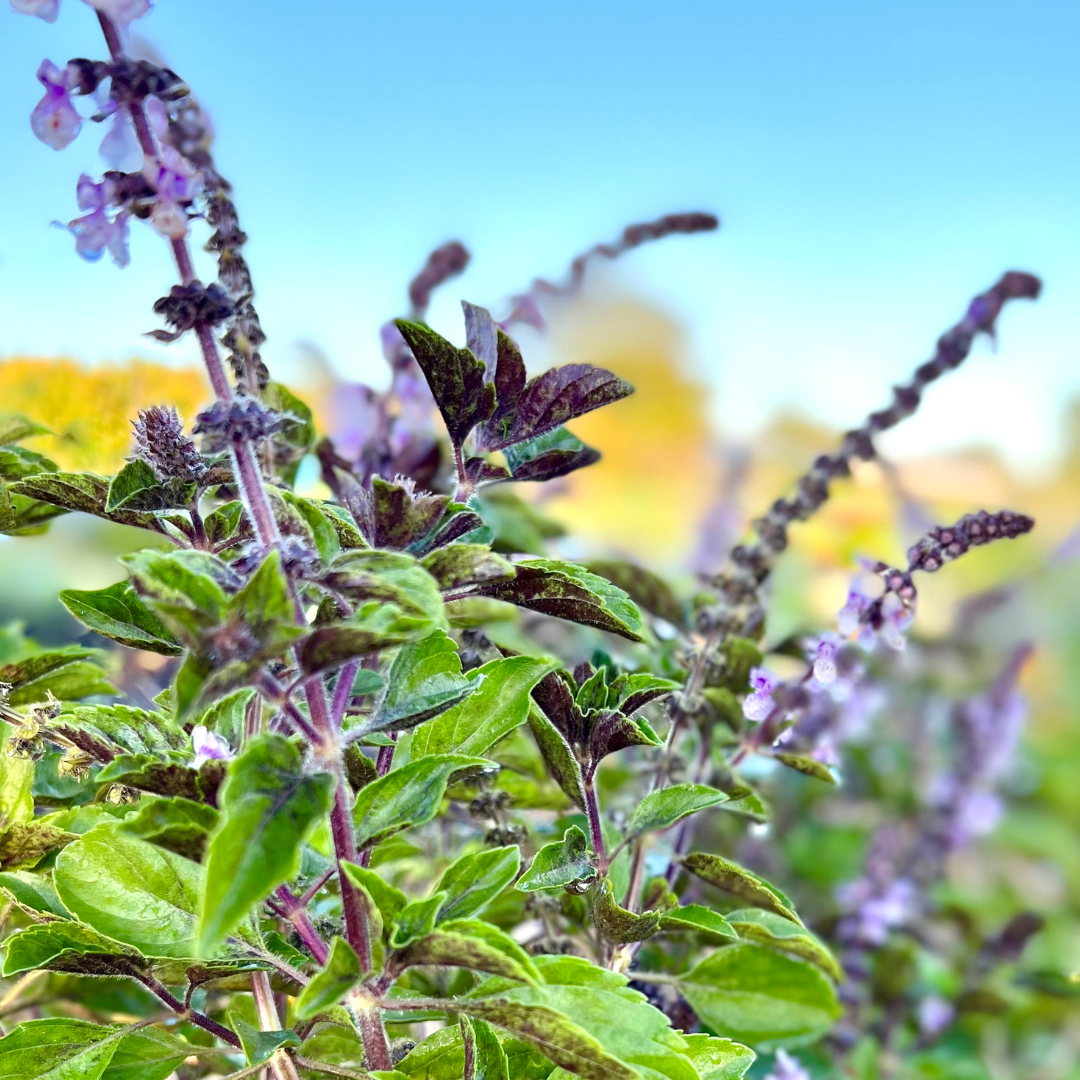Growing a Tulsi Plant: Holy Basil (Plant, Harvest, Preserve)
Tulsi , or Holy Basil, is a revered herb known for its medicinal, culinary, and spiritual benefits. Thriving in sunny, well-drained soil, it requires regular watering and monthly fertilization.
Tulsi, also known as Holy Basil, holds a revered place in Indian culture, both for its spiritual significance and its myriad health benefits. At Sai Nursery in Sydney, we understand the importance of this sacred plant and are here to guide you through the process of planting, harvesting, and preserving Tulsi to ensure you get the best from this wonderful herb.

Planting Tulsi:
Choosing the Right Location: Tulsi thrives in warm, sunny environments. Select a spot in your garden that receives at least 6-8 hours of sunlight each day. If you’re growing Tulsi indoors, place it near a south-facing window.
Soil Preparation: Tulsi prefers well-drained, loamy soil with a neutral pH. Enrich the soil with organic compost to enhance fertility and ensure good drainage.
Planting the Seeds: Sow Tulsi seeds just below the surface of the soil. Keep the soil consistently moist but not waterlogged. Seeds typically germinate within 1-2 weeks. Once the seedlings have developed a few sets of true leaves, they can be transplanted to their final location.
Watering: Water the Tulsi plant regularly, keeping the soil evenly moist. Be cautious not to overwater, as this can lead to root rot. During the summer months, Tulsi may require more frequent watering.
Fertilizing: Feed the Tulsi plant with a balanced, organic fertilizer once a month during the growing season. Avoid over-fertilizing, as this can lead to excessive leaf growth with less potency.
Harvesting Tulsi
When to Harvest: The best time to harvest Tulsi is in the morning after the dew has evaporated but before the sun is too intense. This is when the essential oils in the leaves are at their peak.
How to Harvest: To harvest Tulsi, pinch off the leaves just above a pair of leaves to encourage bushier growth. You can also harvest entire stems if needed. Regular harvesting will promote new growth and keep the plant healthy.
Using Fresh Tulsi: Fresh Tulsi leaves can be used immediately in teas, culinary dishes, or for medicinal purposes. The leaves are rich in essential oils that provide a host of health benefits, from boosting immunity to reducing stress.
Preserving Tulsi
Drying Tulsi: To preserve Tulsi for later use, you can dry the leaves. Spread the harvested leaves on a clean cloth or a drying rack in a well-ventilated, shaded area. Turn the leaves occasionally to ensure even drying. Once completely dry, store the leaves in an airtight container away from direct sunlight.
Freezing Tulsi: Alternatively, you can freeze Tulsi leaves. Wash and pat dry the leaves, then place them in a single layer on a baking sheet and freeze. Once frozen, transfer the leaves to an airtight container or freezer bag. Frozen Tulsi retains much of its flavor and potency.
Making Tulsi Oil: Another preservation method is to make Tulsi oil. Infuse fresh or dried Tulsi leaves in a carrier oil like coconut or olive oil. Store the infusion in a dark, cool place for 2-3 weeks, shaking it occasionally. Strain the leaves and store the oil in a dark glass bottle.
Caring for Your Tulsi Plant
Pruning: Regular pruning is essential to maintain the shape and health of your Tulsi plant. Trim back any leggy or dead stems to encourage bushier growth.
Pest Control: Tulsi is generally resistant to pests, but it can occasionally be affected by aphids or spider mites. Use organic insecticidal soap or neem oil to manage these pests if necessary.
Winter Care: In colder climates, bring your Tulsi plant indoors during the winter months. Place it in a sunny spot and reduce watering to prevent root rot.
Benefits of Growing Tulsi
Health Benefits: Tulsi is known for its medicinal properties, including its ability to boost immunity, reduce stress, and promote respiratory health. It is rich in antioxidants and has anti-inflammatory, antibacterial, and antiviral properties.
Spiritual Significance: In Hindu culture, Tulsi is considered a sacred plant and is often grown near homes and temples. It is believed to purify the environment and bring positive energy.
Culinary Uses: Tulsi leaves add a unique flavor to teas, soups, and other culinary dishes. They can also be used to make herbal remedies and essential oils.
Conclusion
At Sai Nursery in Sydney, we are dedicated to helping you cultivate and care for your Tulsi plant. With the right care and attention, your Tulsi plant will thrive, providing you with an abundant supply of this holy herb. Whether you’re growing Tulsi for its health benefits, culinary uses, or spiritual significance, we are here to support you every step of the way. Visit Sai Nursery for all your gardening needs and expert advice on growing Tulsi and other beneficial plants.
Also Read: Rosemary: A Timeless Herb for Your Garden
.png)